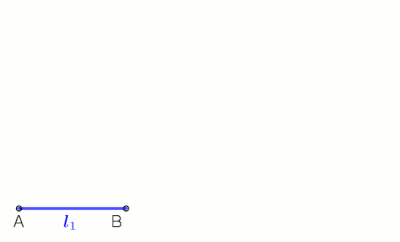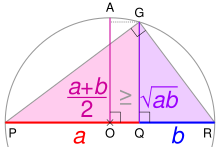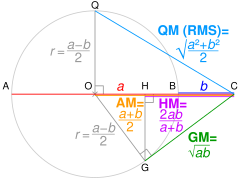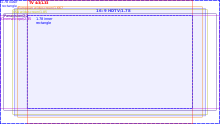Geometric mean

In mathematics, thegeometric meanis ameanoraveragewhich indicates acentral tendencyof a finite set ofreal numbersby using the product of their values (as opposed to thearithmetic meanwhich uses their sum). The geometric mean is defined as thenth rootof theproductofnnumbers, i.e., for a set of numbersa1,a2,...,an,the geometric mean is defined as
or, equivalently, as thearithmetic meaninlogscale:
Most commonly the numbers are restricted to being non-negative, to avoid complications related to negative numbers not having real roots, and frequently they are restricted to being positive, to enable the use of logarithms. In any case, the geometric mean is equal to zero for any data set where one or more values is equal to zero. The geometric mean can be an unreliable measure of central tendency for a dataset where one or more values are extremely close to zero in comparison to the other members of the dataset.
The geometric mean of two numbers, say 2 and 8, is just thesquare rootof their product, that is,.The geometric mean of the three numbers 4, 1, and 1/32 is thecube rootof their product (1/8), which is 1/2, that is,.
The geometric mean is often used for a set of numbers whose values are meant to be multiplied together or are exponential in nature, such as a set of growth figures: values of thehuman populationor interest rates of a financial investment over time. It also applies tobenchmarking,where it is particularly useful for computing means ofspeedup ratios:since the mean of 0.5x (half as fast) and 2x (twice as fast) will be 1 (i.e., no speedup overall).
Suppose for example a person invests 1000 dollars in shares and achieves annual returns of +10%, -12%, +90%, -30% and +25% over 5 consecutive years to give a final investment value of 1,609 dollars. The arithmetic mean of the annual percent changes is 16.6%. However, this value is unrepresentative. If the initial investment, grew by 16.6% per annum, it would be worth 2155 dollars after 5 years. In fact, to find the average percentage growth it is necessary compute the geometric mean of the successive annual growth ratios (1.1, 0.88, 1.9, 0.7, 1.25). This gives a value of 1.0998 which corresponds to an annual average growth of 9.98%. It can be readily verified that an investment of 1000 dollars which grows by 9.98% over five years would achieve a final investment value of 1,609 dollars. In this case, the geometric mean is appropriate because investment growth is multiplicative rather than additive.
The geometric mean can be understood in terms ofgeometry.The geometric mean of two numbers,and,is the length of one side of asquarewhose area is equal to the area of arectanglewith sides of lengthsand.Similarly, the geometric mean of three numbers,,,and,is the length of one edge of acubewhose volume is the same as that of acuboidwith sides whose lengths are equal to the three given numbers.
The geometric mean is one of the three classicalPythagorean means,together with the arithmetic mean and theharmonic mean.For all positive data sets containing at least one pair of unequal values, the harmonic mean is always the least of the three means, while the arithmetic mean is always the greatest of the three and the geometric mean is always in between (seeInequality of arithmetic and geometric means.)
Calculation[edit]
The geometric mean of a data setis given by:
The above figure usescapital pi notationto show a series of multiplications. Each side of the equal sign shows that a set of values is multiplied in succession (the number of values is represented by "n" ) to give a totalproductof the set, and then thenth root of the total product is taken to give the geometric mean of the original set. For example, in a set of four numbers,the product ofis,and the geometric mean is the fourth root of 24, or ~ 2.213. The exponenton the left side is equivalent to the takingnth root. For example,.
Iterative means[edit]
The geometric mean of a data setis less thanthe data set'sarithmetic meanunless all members of the data set are equal, in which case the geometric and arithmetic means are equal. This allows the definition of thearithmetic-geometric mean,an intersection of the two which always lies in between.
The geometric mean is also thearithmetic-harmonic meanin the sense that if twosequences() and () are defined:
and
whereis theharmonic meanof the previous values of the two sequences, thenandwill converge to the geometric mean ofand.The sequences converge to a common limit, and the geometric mean is preserved:
Replacing the arithmetic and harmonic mean by a pair ofgeneralized meansof opposite, finite exponents yields the same result.
Relationship with logarithms[edit]
The geometric mean can also be expressed as the exponential of the arithmetic mean of logarithms.[4]By usinglogarithmic identitiesto transform the formula, the multiplications can be expressed as a sum and the power as a multiplication:
When
- As:
- alternatively, use any positive real number base, for both the logarithms and the number you are raising to the power of the arithmetic mean of the individual logarithms at that same base.
additionally, if negative values of theare allowed,
wheremis the number of negative numbers.
This is sometimes called thelog-average(not to be confused with thelogarithmic average). It is simply computing thearithmetic meanof the logarithm-transformed values of(i.e., the arithmetic mean on the log scale) and then using the exponentiation to return the computation to the original scale, i.e., it is thegeneralised f-meanwith.For example, the geometric mean of 2 and 8 can be calculated as the following, whereis any base of alogarithm(commonly 2,or 10):
Related to the above, it can be seen that for a given sample of points,the geometric mean is the minimizer of
- ,
whereas the arithmetic mean is the minimizer of
- .
Thus, the geometric mean provides a summary of the samples whose exponent best matches the exponents of the samples (in the least squares sense).
The log form of the geometric mean is generally the preferred alternative for implementation in computer languages because calculating the product of many numbers can lead to anarithmetic overfloworarithmetic underflow.This is less likely to occur with the sum of the logarithms for each number.
Comparison to arithmetic mean[edit]

PR is the diameter of a circle centered on O; its radius AO is thearithmetic meanofaandb.Using thegeometric mean theorem,triangle PGR'saltitudeGQ is thegeometric mean.For any ratioa:b,AO ≥ GQ.

The geometric mean of a non-empty data set of (positive) numbers is always at most their arithmetic mean. Equality is only obtained when all numbers in the data set are equal; otherwise, the geometric mean is smaller. For example, the geometric mean of 2 and 3 is 2.45, while their arithmetic mean is 2.5. In particular, this means that when a set of non-identical numbers is subjected to amean-preserving spread— that is, the elements of the set are "spread apart" more from each other while leaving the arithmetic mean unchanged — their geometric mean decreases.[5]
Average growth rate[edit]
In many cases the geometric mean is the best measure to determine the average growth rate of some quantity. (For example, if in one year sales increases by 80% and the next year by 25%, the end result is the same as that of a constant growth rate of 50%, since the geometric mean of 1.80 and 1.25 is 1.50.) In order to determine the average growth rate, it is not necessary to take the product of the measured growth rates at every step. Let the quantity be given as the sequence,whereis the number of steps from the initial to final state. The growth rate between successive measurementsandis.The geometric mean of these growth rates is then just:
Application to normalized values[edit]
The fundamental property of the geometric mean, which does not hold for any other mean, is that for two sequencesandof equal length,
This makes the geometric mean the only correct mean when averagingnormalizedresults; that is, results that are presented as ratios to reference values.[6]This is the case when presenting computer performance with respect to a reference computer, or when computing a single average index from several heterogeneous sources (for example, life expectancy, education years, and infant mortality). In this scenario, using the arithmetic or harmonic mean would change the ranking of the results depending on what is used as a reference. For example, take the following comparison of execution time of computer programs:
Table 1
| Computer A | Computer B | Computer C | |
|---|---|---|---|
| Program 1 | 1 | 10 | 20 |
| Program 2 | 1000 | 100 | 20 |
| Arithmetic mean | 500.5 | 55 | 20 |
| Geometric mean | 31.622... | 31.622... | 20 |
| Harmonic mean | 1.998... | 18.182... | 20 |
The arithmetic and geometric means "agree" that computer C is the fastest. However, by presenting appropriately normalized valuesandusing the arithmetic mean, we can show either of the other two computers to be the fastest. Normalizing by A's result gives A as the fastest computer according to the arithmetic mean:
Table 2
| Computer A | Computer B | Computer C | |
|---|---|---|---|
| Program 1 | 1 | 10 | 20 |
| Program 2 | 1 | 0.1 | 0.02 |
| Arithmetic mean | 1 | 5.05 | 10.01 |
| Geometric mean | 1 | 1 | 0.632... |
| Harmonic mean | 1 | 0.198... | 0.039... |
while normalizing by B's result gives B as the fastest computer according to the arithmetic mean but A as the fastest according to the harmonic mean:
Table 3
| Computer A | Computer B | Computer C | |
|---|---|---|---|
| Program 1 | 0.1 | 1 | 2 |
| Program 2 | 10 | 1 | 0.2 |
| Arithmetic mean | 5.05 | 1 | 1.1 |
| Geometric mean | 1 | 1 | 0.632 |
| Harmonic mean | 0.198... | 1 | 0.363... |
and normalizing by C's result gives C as the fastest computer according to the arithmetic mean but A as the fastest according to the harmonic mean:
Table 4
| Computer A | Computer B | Computer C | |
|---|---|---|---|
| Program 1 | 0.05 | 0.5 | 1 |
| Program 2 | 50 | 5 | 1 |
| Arithmetic mean | 25.025 | 2.75 | 1 |
| Geometric mean | 1.581... | 1.581... | 1 |
| Harmonic mean | 0.099... | 0.909... | 1 |
In all cases, the ranking given by the geometric mean stays the same as the one obtained with unnormalized values.
However, this reasoning has been questioned.[7] Giving consistent results is not always equal to giving the correct results. In general, it is more rigorous to assign weights to each of the programs, calculate the average weighted execution time (using the arithmetic mean), and then normalize that result to one of the computers. The three tables above just give a different weight to each of the programs, explaining the inconsistent results of the arithmetic and harmonic means (Table 4 gives equal weight to both programs, the Table 2 gives a weight of 1/1000 to the second program, and the Table 3 gives a weight of 1/100 to the second program and 1/10 to the first one). The use of the geometric mean for aggregating performance numbers should be avoided if possible, because multiplying execution times has no physical meaning, in contrast to adding times as in the arithmetic mean. Metrics that are inversely proportional to time (speedup,IPC) should be averaged using the harmonic mean.
The geometric mean can be derived from thegeneralized meanas its limit asgoes to zero. Similarly, this is possible for the weighted geometric mean.
Geometric mean of a continuous function[edit]
Ifis a positive continuous real-valued function, its geometric mean over this interval is
For instance, taking the identity functionover the unit interval shows that the geometric mean of the positive numbers between 0 and 1 is equal to.
Applications[edit]
Proportional growth[edit]
The geometric mean is more appropriate than thearithmetic meanfor describing proportional growth, bothexponential growth(constant proportional growth) and varying growth; in business the geometric mean of growth rates is known as thecompound annual growth rate(CAGR). The geometric mean of growth over periods yields the equivalent constant growth rate that would yield the same final amount.
Suppose an orange tree yields 100 oranges one year and then 180, 210 and 300 the following years, so the growth is 80%, 16.6666% and 42.8571% for each year respectively. Using thearithmetic meancalculates a (linear) average growth of 46.5079% (80% + 16.6666% + 42.8571%, that sum then divided by 3). However, if we start with 100 oranges and let it grow 46.5079% each year, the result is 314 oranges, not 300, so the linear averageover-states the year-on-year growth.
Instead, we can use the geometric mean. Growing with 80% corresponds to multiplying with 1.80, so we take the geometric mean of 1.80, 1.166666 and 1.428571, i.e.;thus the "average" growth per year is 44.2249%. If we start with 100 oranges and let the number grow with 44.2249% each year, the result is 300 oranges.
Financial[edit]
The geometric mean has from time to time been used to calculate financial indices (the averaging is over the components of the index). For example, in the past theFT 30index used a geometric mean.[8]It is also used in theCPIcalculation[9]and recently introduced "RPIJ"measure of inflation in the United Kingdom and in the European Union.
This has the effect of understating movements in the index compared to using the arithmetic mean.[8]
Applications in the social sciences[edit]
Although the geometric mean has been relatively rare in computing social statistics, starting from 2010 the United Nations Human Development Index did switch to this mode of calculation, on the grounds that it better reflected the non-substitutable nature of the statistics being compiled and compared:
- The geometric mean decreases the level of substitutability between dimensions [being compared] and at the same time ensures that a 1 percent decline in say life expectancy at birth has the same impact on the HDI as a 1 percent decline in education or income. Thus, as a basis for comparisons of achievements, this method is also more respectful of the intrinsic differences across the dimensions than a simple average.[10]
Not all values used to compute theHDI (Human Development Index)are normalized; some of them instead have the form.This makes the choice of the geometric mean less obvious than one would expect from the "Properties" section above.
The equally distributed welfare equivalent income associated with anAtkinson Indexwith an inequality aversion parameter of 1.0 is simply the geometric mean of incomes. For values other than one, the equivalent value is anLp normdivided by the number of elements, with p equal to one minus the inequality aversion parameter.
Geometry[edit]

In the case of aright triangle,its altitude is the length of a line extending perpendicularly from the hypotenuse to its 90° vertex. Imagining that this line splits the hypotenuse into two segments, the geometric mean of these segment lengths is the length of the altitude. This property is known as thegeometric mean theorem.
In anellipse,thesemi-minor axisis the geometric mean of the maximum and minimum distances of the ellipse from afocus;it is also the geometric mean of thesemi-major axisand thesemi-latus rectum.Thesemi-major axisof an ellipse is the geometric mean of the distance from the center to either focus and the distance from the center to eitherdirectrix.
Another way to think about it is as follows:
Consider a circle with radius.Now take two diametrically opposite points on the circle and apply pressure from both ends to deform it into an ellipse with semi-major and semi-minor axes of lengthsand.
Since the area of the circle and the ellipse stays the same, we have:
The radius of the circle is the geometric mean of the semi-major and the semi-minor axes of the ellipse formed by deforming the circle.
Distance to thehorizonof asphere(ignoring theeffect of atmospheric refractionwhen atmosphere is present) is equal to the geometric mean of the distance to the closest point of the sphere and the distance to the farthest point of the sphere.
The geometric mean is used in both in the approximation ofsquaring the circleby S.A. Ramanujan[11]and in the construction of theheptadecagonwith "mean proportionals".[12]
Aspect ratios[edit]

The geometric mean has been used in choosing a compromiseaspect ratioin film and video: given two aspect ratios, the geometric mean of them provides a compromise between them, distorting or cropping both in some sense equally. Concretely, two equal area rectangles (with the same center and parallel sides) of different aspect ratios intersect in a rectangle whose aspect ratio is the geometric mean, and their hull (smallest rectangle which contains both of them) likewise has the aspect ratio of their geometric mean.
Inthe choice of 16:9aspect ratio by theSMPTE,balancing 2.35 and 4:3, the geometric mean is,and thus... was chosen. This was discoveredempiricallyby Kerns Powers, who cut out rectangles with equal areas and shaped them to match each of the popular aspect ratios. When overlapped with their center points aligned, he found that all of those aspect ratio rectangles fit within an outer rectangle with an aspect ratio of 1.77:1 and all of them also covered a smaller common inner rectangle with the same aspect ratio 1.77:1.[13]The value found by Powers is exactly the geometric mean of the extreme aspect ratios,4:3(1.33:1) andCinemaScope(2.35:1), which is coincidentally close to(). The intermediate ratios have no effect on the result, only the two extreme ratios.
Applying the same geometric mean technique to 16:9 and 4:3 approximately yields the14:9(...) aspect ratio, which is likewise used as a compromise between these ratios.[14]In this case 14:9 is exactly thearithmetic meanofand,since 14 is the average of 16 and 12, while the precisegeometric meanisbut the two differentmeans,arithmetic and geometric, are approximately equal because both numbers are sufficiently close to each other (a difference of less than 2%).
Paper formats[edit]
The geometric mean is also used to calculate B and C series paper formats. Theformat has an area which is the geometric mean of the areas ofand.For example, the area of a B1 paper is,because it is the geometric mean of the areas of an A0 () and an A1 () paper ().
The same principle applies with the C series, whose area is the geometric mean of the A and B series. For example, the C4 format has an area which is the geometric mean of the areas of A4 and B4.
An advantage that comes from this relationship is that an A4 paper fits inside a C4 envelope, and both fit inside a B4 envelope.
Other applications[edit]
- Spectral flatness:insignal processing,spectral flatness,a measure of how flat or spiky a spectrum is, is defined as the ratio of the geometric mean of the power spectrum to its arithmetic mean.
- Anti-reflective coatings:In optical coatings, where reflection needs to be minimised between two media of refractive indicesn0andn2,the optimum refractive indexn1of theanti-reflective coatingis given by the geometric mean:.
- Subtractive color mixing:Thespectral reflectance curvefor paintmixtures(of equaltintingstrength,opacityanddilution) is approximately the geometric mean of the paints' individual reflectance curves computed at each wavelength of theirspectra.[15]
- Image processing:Thegeometric mean filteris used as a noise filter inimage processing.
- Labor compensation:The geometric mean of a subsistence wage and market value of the labor using capital of employer was suggested as the naturalwagebyJohann von Thünenin 1875.[16]
See also[edit]
- Arithmetic-geometric mean
- Generalized mean
- Geometric mean theorem
- Geometric standard deviation
- Harmonic mean
- Heronian mean
- Heteroscedasticity
- Log-normal distribution
- Muirhead's inequality
- Product
- Pythagorean means
- Quadratic mean
- Quadrature (mathematics)
- Quasi-arithmetic mean(generalized f-mean)
- Rate of return
- Weighted geometric mean
Notes[edit]
- ^If AC =aand BC =b.OC =AMofaandb,and radiusr= QO = OG.
UsingPythagoras' theorem,QC² = QO² + OC² ∴ QC = √QO² + OC²=QM.
Using Pythagoras' theorem, OC² = OG² + GC² ∴ GC = √OC² − OG²=GM.
Usingsimilar triangles,HC/GC=GC/OC∴ HC =GC²/OC=HM.
References[edit]
- ^Matt Friehauf, Mikaela Hertel, Juan Liu, and Stacey Luong"On Compass and Straightedge Constructions: Means"(PDF).UNIVERSITY of WASHINGTON, DEPARTMENT OF MATHEMATICS. 2013.Retrieved14 June2018.
- ^"Euclid, Book VI, Proposition 13".David E. Joyce, Clark University. 2013.Retrieved19 July2019.
- ^"2.5: Geometric Mean".Statistics LibreTexts.2019-04-20.Retrieved2021-08-16.
- ^Crawley, Michael J. (2005).Statistics: An Introduction using R.John Wiley & Sons Ltd.ISBN9780470022986.
- ^Mitchell, Douglas W. (2004). "More on spreads and non-arithmetic means".The Mathematical Gazette.88:142–144.doi:10.1017/S0025557200174534.S2CID168239991.
- ^Fleming, Philip J.; Wallace, John J. (1986)."How not to lie with statistics: the correct way to summarize benchmark results".Communications of the ACM.29(3): 218–221.doi:10.1145/5666.5673.S2CID1047380.
- ^Smith, James E. (1988)."Characterizing computer performance with a single number".Communications of the ACM.31(10): 1202–1206.doi:10.1145/63039.63043.S2CID10805363.
- ^abRowley, Eric E. (1987).The Financial System Today.Manchester University Press.ISBN0719014875.
- ^"Measuring price inflation"(PDF).Government Actury's Department. March 2017.Retrieved15 July2023– via gov.uk.
- ^"Frequently Asked Questions - Human Development Reports".hdr.undp.org.Archivedfrom the original on 2011-03-02.
- ^Ramanujan, S.(1914)."Modular equations and approximations toπ"(PDF).Quarterly Journal of Mathematics.45:350–372.
- ^T.P. StowellExtract from Leybourn's Math. Repository, 1818inThe AnalystviaGoogle Books
- ^ab"TECHNICAL BULLETIN: Understanding Aspect Ratios"(PDF).The CinemaSource Press. 2001.Archived(PDF)from the original on 2009-09-09.Retrieved2009-10-24.
- ^US 5956091,"Method of showing 16:9 pictures on 4:3 displays", issued September 21, 1999
- ^MacEvoy, Bruce."Colormaking Attributes: Measuring Light & Color".handprint.com/LS/CVS/color.html.Colorimetry.Archivedfrom the original on 2019-07-14.Retrieved2020-01-02.
- ^Henry Ludwell Moore(1895).Von Thünen's Theory of Natural Wages.G. H. Ellis.
External links[edit]
- Calculation of the geometric mean of two numbers in comparison to the arithmetic solution
- Arithmetic and geometric means
- When to use the geometric mean
- Practical solutions for calculating geometric mean with different kinds of dataArchived2010-11-12 at theWayback Machine
- Geometric Mean on MathWorld
- Geometric Meaning of the Geometric Mean
- Geometric Mean Calculator for larger data sets
- Computing Congressional apportionment using Geometric Mean
- Non-Newtonian calculus website
- Geometric Mean Definition and Formula
- The Distribution of the Geometric Mean
- The geometric mean?








![{\displaystyle \left(\prod _{i=1}^{n}a_{i}\right)^{\frac {1}{n}}={\sqrt[{n}]{a_{1}a_{2}\cdots a_{n}}}}](https://wikimedia.org/api/rest_v1/media/math/render/svg/d8b67da21f4b58d3121ef21e0c5a9d040a6b65ce)


![{\displaystyle {\sqrt[{3}]{4\cdot 1\cdot 1/32}}=1/2}](https://wikimedia.org/api/rest_v1/media/math/render/svg/dfd83c4a9ce55b2c53c47b9b32e0e99cf2b92bd8)




![{\displaystyle \left(\prod _{i=1}^{n}a_{i}\right)^{\frac {1}{n}}={\sqrt[{n}]{a_{1}a_{2}\cdots a_{n}}}.}](https://wikimedia.org/api/rest_v1/media/math/render/svg/02ce0b254fa59ff1469815211849e01afb2c2639)




![{\textstyle 24^{\frac {1}{4}}={\sqrt[{4}]{24}}}](https://wikimedia.org/api/rest_v1/media/math/render/svg/ebf902fd3a756ded31adb6422871b0f871873ab3)









![{\displaystyle \left(\prod _{i=1}^{n}a_{i}\right)^{\frac {1}{n}}=\exp \left[{\frac {1}{n}}\sum _{i=1}^{n}\ln a_{i}\right];}](https://wikimedia.org/api/rest_v1/media/math/render/svg/bebc299146b954703f19c2b6d77dec555813fac7)
![{\displaystyle {\begin{aligned}\left(\prod _{i=1}^{n}a_{i}\right)^{\frac {1}{n}}&={\sqrt[{n}]{a_{1}a_{2}\cdots a_{n}}}\\&=e^{\ln(a_{1}a_{2}\cdots a_{n})^{1/n}}\\&=e^{{\frac {1}{n}}\left(\ln a_{1}+\ln a_{2}+\cdots +\ln a_{n}\right)}\\&=e^{{\frac {1}{n}}\sum _{i=1}^{n}\ln a_{i}}\\{\text{geometric mean(}}a{\text{)}}&=e^{{\text{arithmetic mean(ln(}}a{\text{))}}}\end{aligned}}}](https://wikimedia.org/api/rest_v1/media/math/render/svg/50c20284ee16e7627c22ce1c8388d96a3c08771f)

![{\displaystyle \left(\prod _{i=1}^{n}a_{i}\right)^{\frac {1}{n}}=\left(\left(-1\right)^{m}\right)^{\frac {1}{n}}\exp \left[{\frac {1}{n}}\sum _{i=1}^{n}\ln \left|a_{i}\right|\right],}](https://wikimedia.org/api/rest_v1/media/math/render/svg/598e2e9ba9f34556b6e603997e98453114daa329)


![{\displaystyle b^{{\frac {1}{2}}\left[\log _{b}(2)+\log _{b}(8)\right]}=4}](https://wikimedia.org/api/rest_v1/media/math/render/svg/464b46540b9c48ef7d26669a6b08b330425a017f)













![{\displaystyle f:[a,b]\to (0,\infty )}](https://wikimedia.org/api/rest_v1/media/math/render/svg/49e9bf1b3d84aa538bedd5481abc3eadbba6cd12)
![{\displaystyle {\text{GM}}[f]=\exp \left({\frac {1}{b-a}}\int _{a}^{b}\ln f(x)dx\right)}](https://wikimedia.org/api/rest_v1/media/math/render/svg/bd70a2776c189e5361b786a6e5121c57addfe52b)


![{\displaystyle {\sqrt[{3}]{1.80\times 1.166666\times 1.428571}}\approx 1.442249}](https://wikimedia.org/api/rest_v1/media/math/render/svg/1da9a200d95bde041252664366636b41eb7fb036)


















